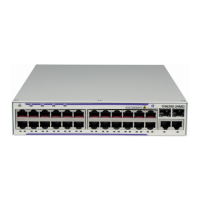Synchronization
Page 160 7210 SAS M, X Basic System Configuration Guide
Synchronous Ethernet
Synchronous Ethernet is a variant of line timing supported on the on Ethernet SFP ports with SFPs
that support Synchronous Ethernet. When synchronous Ethernet is enabled, the operator can select
an Ethernet port as a candidate for timing reference. The timing recovered from this port is used to
time the system. This ensures all the system outputs are locked to a stable and traceable frequency
source.
Synchronous Ethernet is active at Layer 1 and monitors the precision of the following:
• Timing of signal transitions to be relayed.
• Recovery of accurate frequencies.
Synchronous Ethernet is not impacted by traffic load and therefore not affected by packet loss or
PDV that occurs with timing methods that use higher layers of the networking technology.
Synchronous Ethernet can be used only for end-to-end network synchronization when all
intermediate switching nodes in the network have hardware and software support for Synchronous
Ethernet.
Using Synchronous Ethernet Timing for T1/E1 MDA
In 7210 SAS-M and all its variants, the timing recovered from Synchronous Ethernet is available
for use with the T1/E1 MDA. This allows customers to use a stable frequency for timing the T1/E1
ports in applications where ACR is not suitable for use.
Note: Please check the release notes to know software release in which this feature is available.
ACR States
There are five potential ACR states:
•Normal
• Phase tracking
• Frequency tracking
• Holdover
• Free-run

